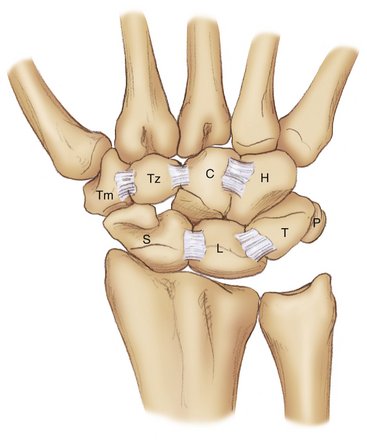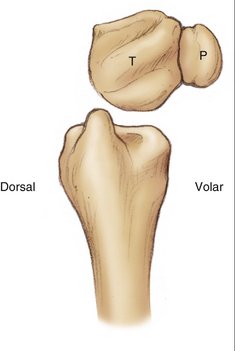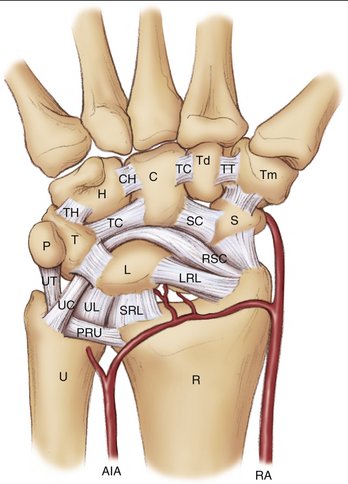CHAPTER 38 Carpal Anatomy
Historical Background
The bones that make up the carpal wrist have names with ancient origins. The name of the scaphoid is derived from the Greek word scaphe, which means “boat” or “trough.”1 The lunate was previously named the semilunar due to its resemblance to the moon, and the translation of lunate is “crescent shaped.” The capitate is also known as the os magnum because it is the largest bone in the carpus. Finally, the pisiform translates to “pea,” which matches the size and shape of this bone.
Much of the modern original work in the anatomy of the wrist was performed by Landsmeer, whose painstaking dissection was the basis for the names of many wrist ligaments. Landsmeer published his atlas of hand anatomy2 and coauthored a landmark paper with Berger describing the extrinsic ligament anatomy of the carpus.3
Osseous Anatomy
The wrist is the link between the forearm and the hand. The carpus is made up of 15 bones excluding the sesamoids and supernumerary bones (Fig. 38-1). These include the distal radius and ulna, the two rows of the carpus, and the bases of the five metacarpals. The carpal rows are divided into the proximal and distal carpal rows. In the proximal carpal row are found the scaphoid, lunate, triquetrum, and pisiform. The pisiform articulates only with the triquetrum, because it lies volar to it and is enveloped by the flexor carpi ulnaris tendon except on its deep surface (Fig. 38-2). The pisiform is considered by many to be a sesamoid bone but provides an important lever arm for the flexor carpi ulnaris tendon. The trapezium, trapezoid, capitate, and hamate make up the distal carpal row from radial to ulnar in the wrist. The hook of the hamate extends volarly 1 to 2 cm radial and distal to the pisiform and serves as the attachment site for several ligaments.1 The five metacarpal bases articulate with this row of carpal bones.
The carpus includes three specific joint types: the radiocarpal joint, the midcarpal joint, and the carpometacarpal joints. The radiocarpal joint is composed of the distal articular surface of the radius in addition to the triangular fibrocartilage complex. The distal radius has two articular facets, named after the carpal bone they contact—the scaphoid and lunate facets, respectively.4 The facets on the radius are divided by the interfossal ridge, which is often a raised portion of the radius but can also have a fibrous ridge to it. The distal radius and triangular fibrocartilage complex articulate as a whole with the proximal carpal row, which forms a convex articular facet.
Ligamentous Anatomy
All of the ligaments of the wrist are intracapsular with the exception of three ligaments: the transverse carpal ligament, or flexor retinaculum, the pisohamate ligament, and the pisometacarpal ligament. Nearly all the wrist ligaments are contained within capsular sheaths of loose connective tissue and fat. This often makes it difficult to visualize individual ligaments when approaching the carpal joints surgically. From within the joints, the ligaments can be viewed as distinct structures, best seen during wrist arthroscopy or visualizing the volar ligaments via a dorsal approach between the carpal bones.5,6
Extrinsic Carpal Ligaments
The extrinsic ligaments of the carpus provide support and form the linkage between the long bones of the forearm and the eight carpal bones. The volar extrinsic ligaments form an inverted “V”-shaped configuration and are best visualized during wrist arthroscopy. In fact, visualization of the ligaments from outside the wrist joint is nearly impossible as the capsule of the wrist blends the extrinsic ligaments together. These ligaments include the radioscaphocapitate, long radiolunate, radioscapholunate, and short radiolunate ligaments on the radial carpus. The ulnolunate, ulnolunocapitate, and ulnotriquetrocapitate ligaments form the volar ulnar ligamentous complex (Fig. 38-3).
On the radial side of the wrist, the radioscaphocapitate ligament originates in a broad sheet from the tip of the radial styloid to the midscaphoid fossa and inserts on the distal scaphoid pole, acting as a support to the waist of the scaphoid. The next ulnar ligament is the long radiolunate ligament, which originates from the remaining portion of the scaphoid fossa of the radius and attaches to the radial volar aspect of the lunate.3 Abutting the long radiolunate ligament is the radioscapholunate ligament (or ligament of Testut), which is not actually a true ligament but is rather a capsular tissue through which course blood vessels, including terminal branches of the anterior interosseous artery.7 This structure goes through the volar capsule and attaches dorsally into the scapholunate interosseous ligament. Finally, the short radiolunate ligament has its origin from the lunate fossa and inserts onto the radial side of the lunate (Fig. 38-4).8











